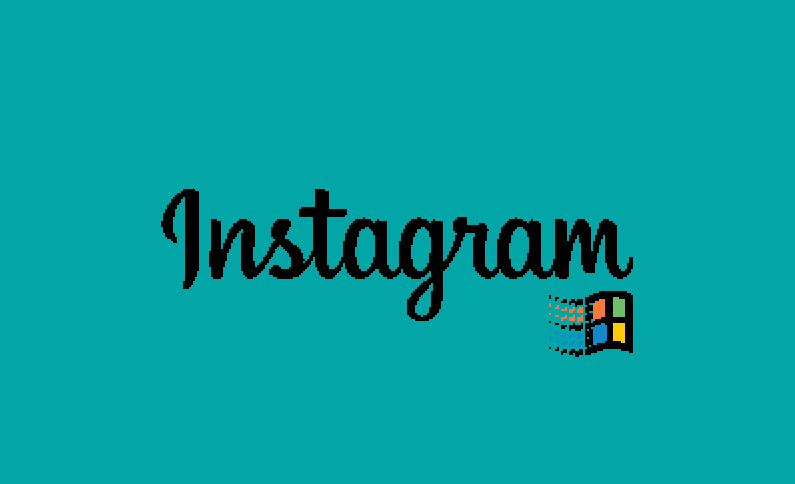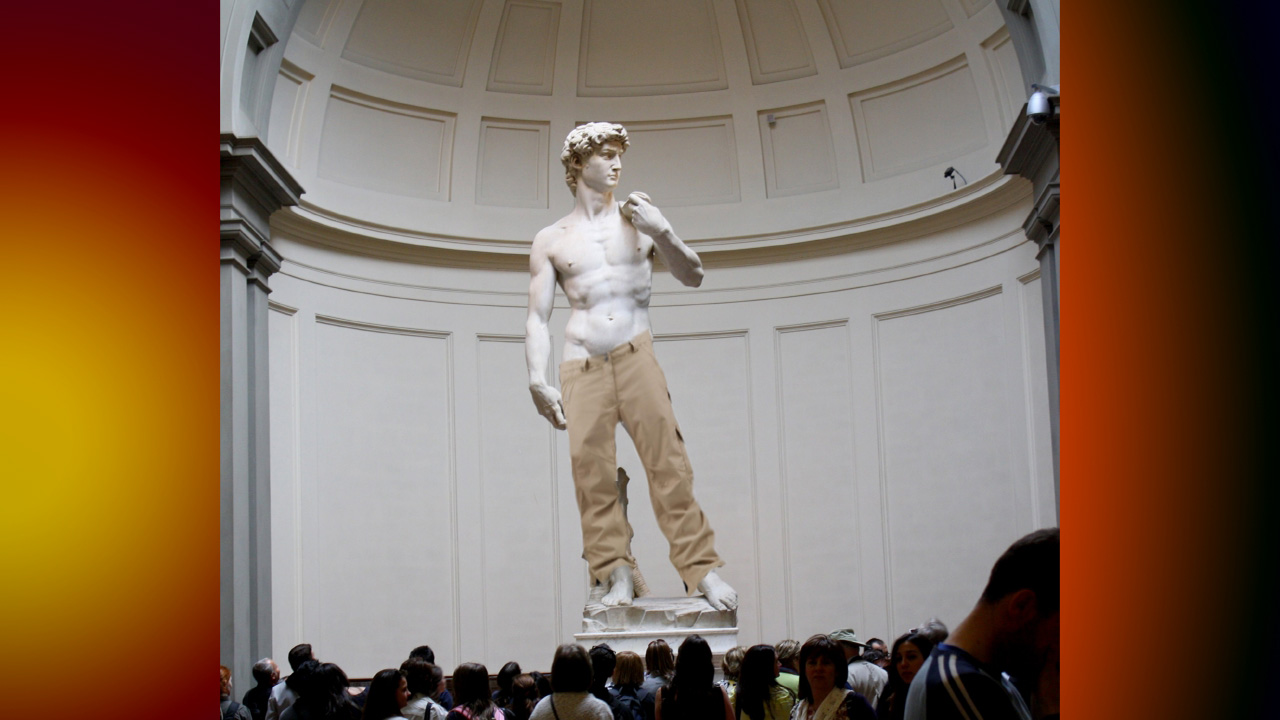National Geographic has produced an excellent series on the history of sex and sexuality. As part of that series, they ran an episode on sex and technology. If you watch closely, you can see me talking about the history of computer dating as first described on this post on this blog!
Rolandt
Shared posts
Fun won't get it done
OK, published at 3:30 AM. That's a first!
So. Got something you want to do over the coarse of a year? Here's a motivation woefully insufficient to pull it off:
- It's fun!
What could give you enough drive to finish the job? Anything with a reward in the future, once you're done:
- Millions of fans will adore me.
- It will be the ugliest thing on the planet.
- I will finally understand quantum neural rockets.
- We will see who the loser is, Todd!
- I will help humanity.
- I will destroy humanity.
It doesn't matter how noble or ignoble your goal is. What matters is delaying gratification. Because even your favorite thing in the world will have shitty bits if you chew on a big enough chunk of it. A few months or years worth of work are always a big enough chunk, so there will be shitty bits. Unfortunately, it's also the minimum-sized chunk to do anything of significance.
This is where many brilliant talents drown. Having known the joy of true inspiration, it's hard to settle for less, which you must to have any impact. Meanwhile, their thicker peers happily butcher task after task. Before you know it, these tasks add up to an impactful result.
In hindsight, I was really lucky in that I chose a profession for money instead of love. Why? Stamina. Money is a reward in the future that lets you ignore the shittier bits of the present.
Loving every moment of it, on the other hand, carries you until that moment which you hate, and then you need a new sort of fuel. Believe me, I know. I love drawing and animation, and you won't believe how many times I started and stopped doing it.
But the animation teacher who taught me 3D said he was happy to put textures on toilet seat models when he started out. That's the kind of appetite you need – and very few people naturally feel that sort of attraction to toilet seats. You need a big reward in the future, like "I'm going to become a pro," to pull it off.
But I don't want to become a pro. I don't want to work in the Israeli animation market where there's scarcely a feature film made. I don't even want to work for a big overseas animation studio. I want to make something, erm, something beautiful that I love, which is a piece of shit of a goal.
Because you know where I made most progress picking up actual skills? In an evening animation school, where I had a perfectly good goal: survive. It's good because it's a simple, binary thing which doesn't give a rat's ass about your mood. You either drop out or you don't. But "something I love" is fluid, and depends a lot on the mood. And when you hate this thing you're making, as you sometimes will, it's hard to imagine loving it later.
Conversely, imagining how I don't drop out is easy. This is what I was imagining when sculpting this bust, which 90% of the time I hated with a passion because it looked like crap. But I thought, "I'm not quitting, I'm not quitting, I'm not quitting, hey, I get the point of re-topology in Mudbox, I'm not quitting, I'm not quitting, hey, I guess I see what the specular map does, I'm not quitting… Guess I'm done!"
And now let's talk about beauty for a moment.
I'm a programmer. I like to think that I'm not the thickest, butcherest programmer, in that I understand the role of beauty in it. For the trained eye, programs can be beautiful as much as math, physics or chess, and a beautiful program is better for business than the needlessly uglier program. (Ever tried pitching the value of beauty to someone businessy? Loads of fun.)
But you know why beauty is your enemy? Because it sucks the fun out of things. How? Because you're making this thing and chances are, it's not beautiful according to your own standard. The trap is, your taste for beauty is usually ahead of your creative ability. In any area, and then in any sub-area of that area, ad infinitum, you can tell ugly from beautiful long before you can make something beautiful yourself. And even if you can satisfy your own taste, often the final thing is beautiful, but not the states it goes through.
So the passionate, sensitive soul is hit twice:
- You're driven by fun and inspiration because you've once experienced it and now you covet it.
- Your sense of beauty, frustrated by the state of your creation, kills all the fun – that very fun which you insist must be your only fuel.
Life is easier if you want a yacht. I think you can buy a decent one for $300K, and certainly for $1M. Now all you need to do is make that money, doing doesn't matter what – imagining that yacht will help you do anything well! If you want beauty, however, I do not envy you.
How do I cope with my desire for beauty? The first step is acknowledging the problem, which I do. The fact is that my worst failures in programming came when I insisted on beauty the most. The second step is shunning beauty as a goal, and making it into a means and a side-effect.
I need a program doing at least X, taking at most Y seconds, at a date not later than Z. I'll keep ugliness to a minimum because ugly programs work badly. And if it comes out particularly nicely, that's great. But beauty is not a goal, and enjoying the beauty of this program as I write it is not why I write it.
And if you think it's true for commercial work but not open source software, look at, I dunno, Linux. Read some Torvalds:
Realistically, every single release, most of it is just driver work. Which is kind of boring in the sense there is nothing fundamentally interesting in a driver, it's just support for yet another chipset or something, and at the same time that's kind of the bread and butter of the kernel. More than half of the kernel is just drivers, and so all the big exciting smart things we do, in the end it pales when compared to all the work we just do to support new hardware.
Boring bits. Boring bits that must be done to make something of value.
Does this transfer to art or poetry or any of those things whose whole point is beauty? Well, yeah, I think it does, because no, beauty is not the whole point:
- The most important thing about a drawing is that it's done. Now it exists, and people can see it, and you can make another one. Practice. They will not come out very well if they don't come out.
- Often people like your subject. There's a continuum between "it's beautiful in a way that words cannot convey" and "I love how this song expresses my favorite political philosophy." To the extent that a work of art tells a story, or even sets up a mood, its beauty does become a means to an end.
- Just because the end result is beautiful to the observer, and even if that's the only point, doesn't mean every step making it was an orgy of beauty for whomever made it. Part of what goes into it is boring, technical work.
So here, too I'm trying to make beauty a non-goal. Instead my goals are "make a point" and "keep going," and you try to add beauty, or remove ugliness, as you go.
For example, I didn't do a graduation project in the evening school, but I animated a short on my own in the same timeframe, and I published it, even though it's not the beautiful thing I always dreamed about making. And I'm not sure anyone gets the joke except me. (I'm not sure I get it anymore, either.)
Now my goal is "make another one." It's a good goal, because it's easy to imagine making another one. It's proper delayed gratification.
And if you've enjoyed programming 20 years ago and are trying to reignite the passion, I suggest that you find a goal as worthy for you as "fun" or "beauty", but as clear and binary as a yacht. And you can settle for less worthy, but not for less clear and binary. Because everything they told you about "extrinsic motivation" being inferior to "intrinsic motivation" is one big lie. And this lie will fall apart the moment you sink your teeth into a bunch of shit, as will always happen if you're trying to accomplish anything.
Follow me on Twitter to receive pearls of wisdom such as the following sample:
Authority is the idea that what matters is not which answer is pulled out of the ass, but whose ass it's pulled out of.
— Yossi Kreinin (@YossiKreinin) July 21, 2016
Studying the viral growth of a connective action network using information event signatures
Jeff Hemsley,
First Monday,
Aug 03, 2016
Interesting paper studying the growth and decline of 'connective action networks' such as the Occupy movement and the Arab spring. " A connective action network supports collective action by employing technologies that link together users who all have their own network." Tracking the growth of these networks lets us know when a protest will become a movement, and when (or how soon) a movement will begin to decay (contrast these with 'viral phenomena' which show a rapid rise in growth (often with the help of promotion) and an equally steep decline after the fad has passed. "This work suggests there phases of growth similar to the diffusion of innovations (Rogers, 1995): a period of ramping up, followed by a faster increase and then slowdown in growth." Interestingly, the Occupy network still exists, and even though it has been relatively quiet, the right events could cause it to become active again.
[Link] [Comment]trendwatching.com | RECONCILIATION BRANDS | Consumer Trend Briefing | August 2016
Why smart brands are taking action to promote social harmony and repair the bonds of our shared humanity!
Read the RECONCILIATION BRANDS Consumer Trend Briefing from trendwatching.com »
Apple Airs New iPad Pro Commercial, Asks “What’s a Computer?”

Apple posted a new iPad Pro commercial today, highlighting the nature of the device as a new kind of computer.
The ad follows a simple model: it showcases common usage of an iPad Pro with accessories, apps, and system features that aren't available on traditional computers. The video jumps from showing the Apple Pencil to mentioning the iPad's touch screen, the detachable Smart Keyboard, and apps like Office and Procreate that offer unique functionality on iOS 9. At the end, iMessage in Split View and Picture in Picture (also two features of last year's iPad-focused iOS 9 update) make an appearance.
In the narration of the ad, Apple explains:
Just when you think you know what a computer is, you see a keyboard that can just get out of the way. And a screen you can touch and even write on. When you see a computer that can do all that, it might just make you wonder – "Hey, what else can it do?"
The video closes with the tagline "Imagine what your computer could do if it was an iPad Pro".
The iPad Pro's new commercial comes at an interesting time for Apple. The company announced its latest iPad, the 9.7-inch iPad Pro, as the "ultimate PC replacement" for Windows switchers, but its upcoming iOS 10 update only includes minor iPad changes – a departure from iOS 9's iPad breakthroughs. On the other hand, the iPad line recently returned to revenue growth after several quarters, likely thanks to the iPad Pro and its higher selling price.
Explaining to consumers how an iPad can be a PC replacement and, at the same time, a new take on desktop computing has always been one of Apple's toughest propositions. This new iPad Pro commercial seems to start from the basics again, asking what a computer truly is and how it can be different. It'll be interesting to see if a wider marketing campaign and more commercials will follow.
You can watch the video below.
Like MacStories? Become a Member.
Club MacStories offers exclusive access to extra MacStories content, delivered every week; it’s also a way to support us directly.
Club MacStories will help you discover the best apps for your devices and get the most out of your iPhone, iPad, and Mac. Plus, it’s made in Italy.
Join NowEnhancing Download Protection in Firefox
Protection against malicious downloads was added in Firefox 31 on Windows and in Firefox 39 on Mac and Linux. Thanks to Google’s expansion of their Safe Browsing service, Firefox 48 now extends our existing protection to include two additional kinds of downloads: potentially unwanted software and uncommon downloads.
Expanded protection
The first new category, potentially unwanted software, is meant to flag software that makes unexpected changes to your computer, as explained in the Google policy. It is usually best to avoid this kind of software since it could (for example) collect your personal information without your consent and use techniques to make it difficult to uninstall.
The second category, uncommon downloads, covers downloads which may not be malicious or unwanted but that are simply not commonly downloaded. The purpose of this warning is to draw users’ attention to the fact that this may not be the download they think it is. For example, if you are looking to download a new version of Firefox or a popular software package such as VLC and get this warning, it is possible that you have been tricked into downloading a malicious file from a phishing site which has not yet been identified as such by the Google Safe Browsing service. You may want to double-check the address of the site where you downloaded this file and proceed with caution.
Improved user interface
In addition to the new categories described above, we have made improvements to the user interface to make it easier for users to notice and understand these warnings.
Here is what the download button now looks like when a download has been flagged by download protection:
 Potentially unwanted or uncommon downloads |
 Malicious downloads |
Depending on the category, the default action button will be either “open” or “remove”:
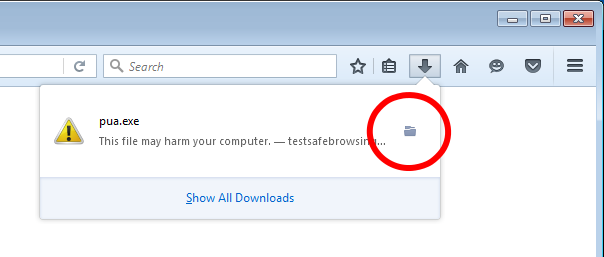
Potentially unwanted downloads
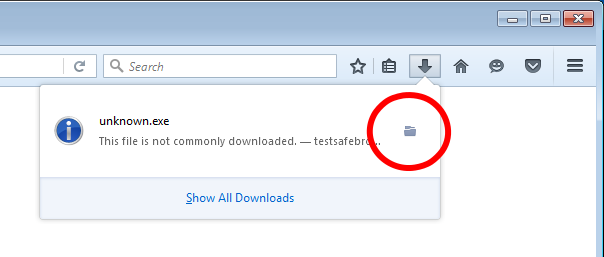
Uncommon downloads

Malicious downloads
and the following confirmation dialog was added to help users understand the risks involved:

Potentially unwanted downloads

Uncommon downloads

Malicious downloads
We have retained the ability for users to override all of these warnings via the contextual menu if they are convinced that the warning is erroneous:
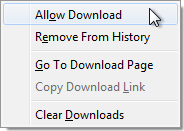
Contextual menu
More control for users
The security options in Firefox had remained the same since browsing protection was first introduced in Firefox 3. This is what they looked like in Firefox 47:
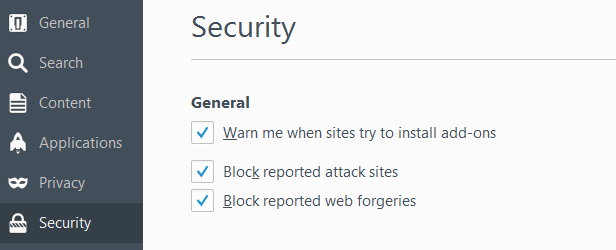
Security options prior to Firefox 48
and this is how they changed in Firefox 48 to give users more control around download and browsing protection:
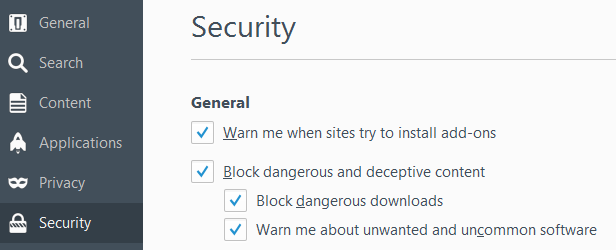
Security options in Firefox 48
While we believe that the vast majority of our users will prefer to keep all of the protections that Safe Browsing offers, we understand that some users may choose to disable parts of the Safe Browsing service based on the privacy guarantees they offer. Our new options aim to give concerned users the necessary level of control and to enable them to retain as much of the Safe Browsing service as they are comfortable with.
Here are what the new options mean:
- Block dangerous and deceptive content: This enables warnings when visiting pages which contain malware or deceptive content. It is required by the rest of the Safe Browsing functionality.
- Block dangerous downloads: This enables the download protection feature which may use a remote server to detect malicious executable files.
- Warn me about unwanted and uncommon software: This extends the download protection feature to also warn about potentially unwanted and uncommon downloads.
Expert users are always welcome to explore (at their own risk) the additional internal configuration settings which are not exposed through the user interface.
Announcing the 2016 edition of Mozilla Winter of Security
 What security engineers do at Mozilla is critical — not for just Firefox users, but for the whole Web. If you’ve ever used the OWASP Zed Attack Proxy, read our security guidelines on SSH and TLS or evaluated your website using the HTTP Observatory, then you have benefitted from the work of Mozilla’s security teams. That’s why we make sure to recruit some of the world’s best talent in the field who want to have a real impact on the Web’s security.
What security engineers do at Mozilla is critical — not for just Firefox users, but for the whole Web. If you’ve ever used the OWASP Zed Attack Proxy, read our security guidelines on SSH and TLS or evaluated your website using the HTTP Observatory, then you have benefitted from the work of Mozilla’s security teams. That’s why we make sure to recruit some of the world’s best talent in the field who want to have a real impact on the Web’s security.
Mozilla Winter of Security (MWoS) is an opportunity for us to do just that, inviting students to pair up with our engineers to contribute to some of Mozilla’s security projects. Today we are announcing that the third-ever MWoS is open for applications.
Every year, we select projects that present an interesting security challenge. For mentors, MWoS is an opportunity to open projects from the Mozilla ecosystem to external contributors, and receive help to make progress in areas they may not have time to focus on. For students, MWoS is a gateway to the open source security world and a chance to solve real-world problems. This mutually beneficial formula has led 33 students to write code for 16 security projects in the last two years. Several of these projects are now fully integrated in the work we do to keep Mozilla and the Internet safe. Take the TLS Observatory, a platform developed by Dimitris Bachtis from Greece (MWoS 2014) that helps operators configure HTTPS properly on their sites. Another example is the MIG Sandbox, a Go package implementing Linux seccomp to secure Mozilla Investigator, and written by Teodora Băluță, Vladimir Diaconescu and Constantin-Alexandru Tudorică from Romania (MWoS 2015).
This year, MWoS has expanded to include Mozilla’s Crypto team with five projects for NSS, the network security library of Firefox. Alongside cryptography, the 2016 edition of MWoS will feature twelve projects spread across various disciplines, including web and infrastructure security. The projects are:
- MIG: A web interface for Mozilla Investigator
- ZAP: Field Enumeration
- ZAP: Form Handling
- ZAP: Automated authentication detection and configuration
- Plug’n’hack / ringleader: Support for e10s (and more)
- NSS: Demos
- NSS: Server integration
- NSS: SHA-3 Implementation
- NSS: Formal Verification
- NSS: TLS Interoperability
- ssh_scan: Improving Scalability and Feature Set
- Security Testing Workflow and Toolchain for Python Websites and Services
A full list of projects with their details is available at https://wiki.mozilla.org/Security/Automation/Winter_Of_Security_2016.
To apply, teams must be engaged in a university program and their professor must agree to give the team credits for their MWoS project. Our experience tells us this requirement ensures students have the time and motivation to work on their project, and helps provide a better mentoring experience for everyone.
Applications open today and will close on September 15th. If you are a professor, we encourage you to tell your students about MWoS. If you are a student looking to have a real impact on the security of the Web, start assembling your team, and fill out the application form before September 15th. We will contact the teams and let them know if they have been selected within two weeks after the deadline.
If you have any questions about the MWoS program or the projects, please contact the mentors directly by email and on Mozilla’s #security IRC channel. We look forward to having you join us!
If Instagram Ran on Windows 95...
 Images courtesy the artist
Images courtesy the artist
People love to complain about Instagram, whether it's changes to their feed algorithm, or their nudity or comment policies, but can you imagine trying to use the app on Windows 95? Russian creative Misha Petrick's tongue-in-cheek new project, Instagram for Win95 puts all our complaints about the platform into perspective. "I made these GIFs because I wanted to make modern kids look at Instagram the way I saw things at that age," Petrick tells The Creators Project. "We are all kids of the 90s and Windows 95 was really cool for us, just like Instagram is cool for children today. The humor comes from the mismatch of these two things."
The wonderfully clunky GIFs show how filters, notifications, and uploads would work in the antiquated operating system. "Instagram.exe" is grainy and pixelated, uses obnoxious dialogue boxes, an awkward scroll bar, and its filters change your pictures to look like the displays of Windows 95 contemporaries like the Apple II and the Commodore VIC-20. It's a mess of an interface that web designers, artists, and anyone who's used to Instagram's sleek modern build will cringe at.
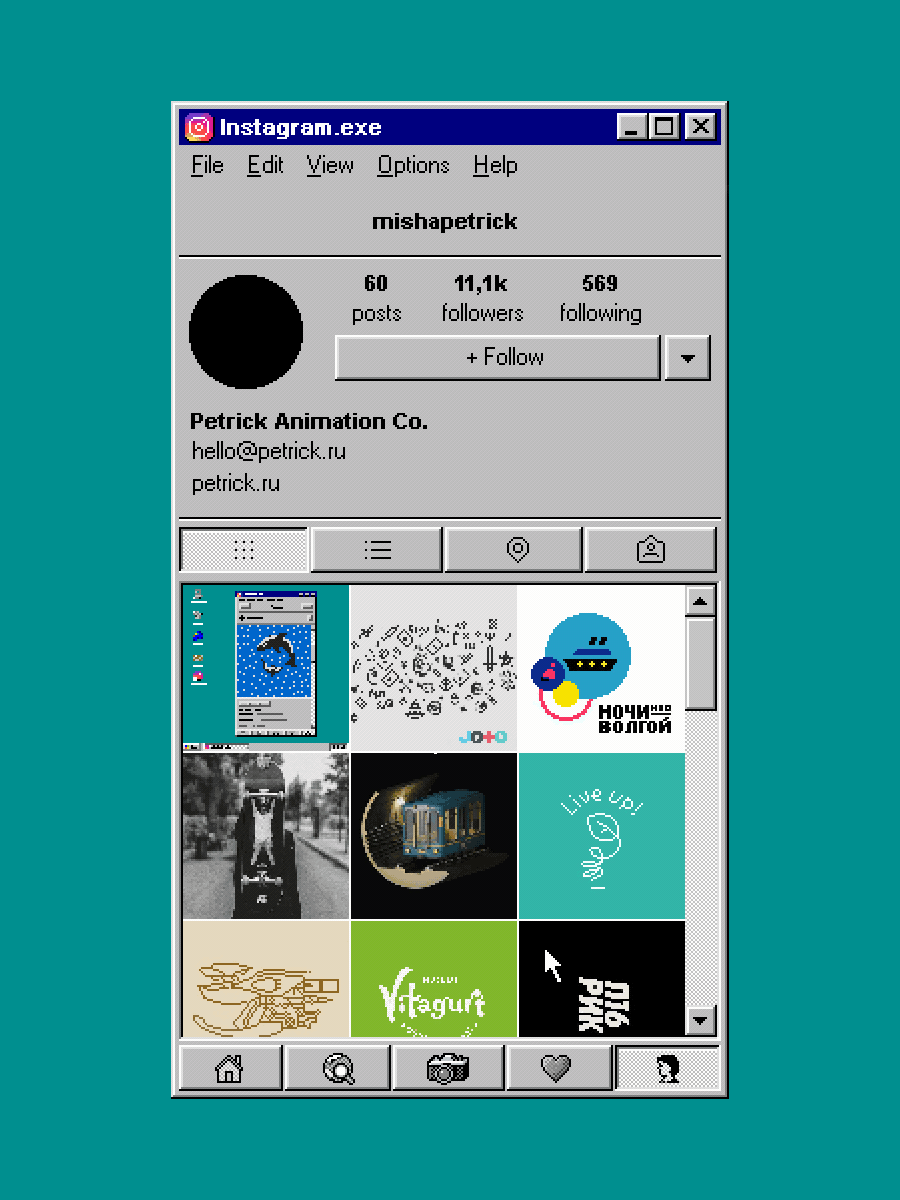
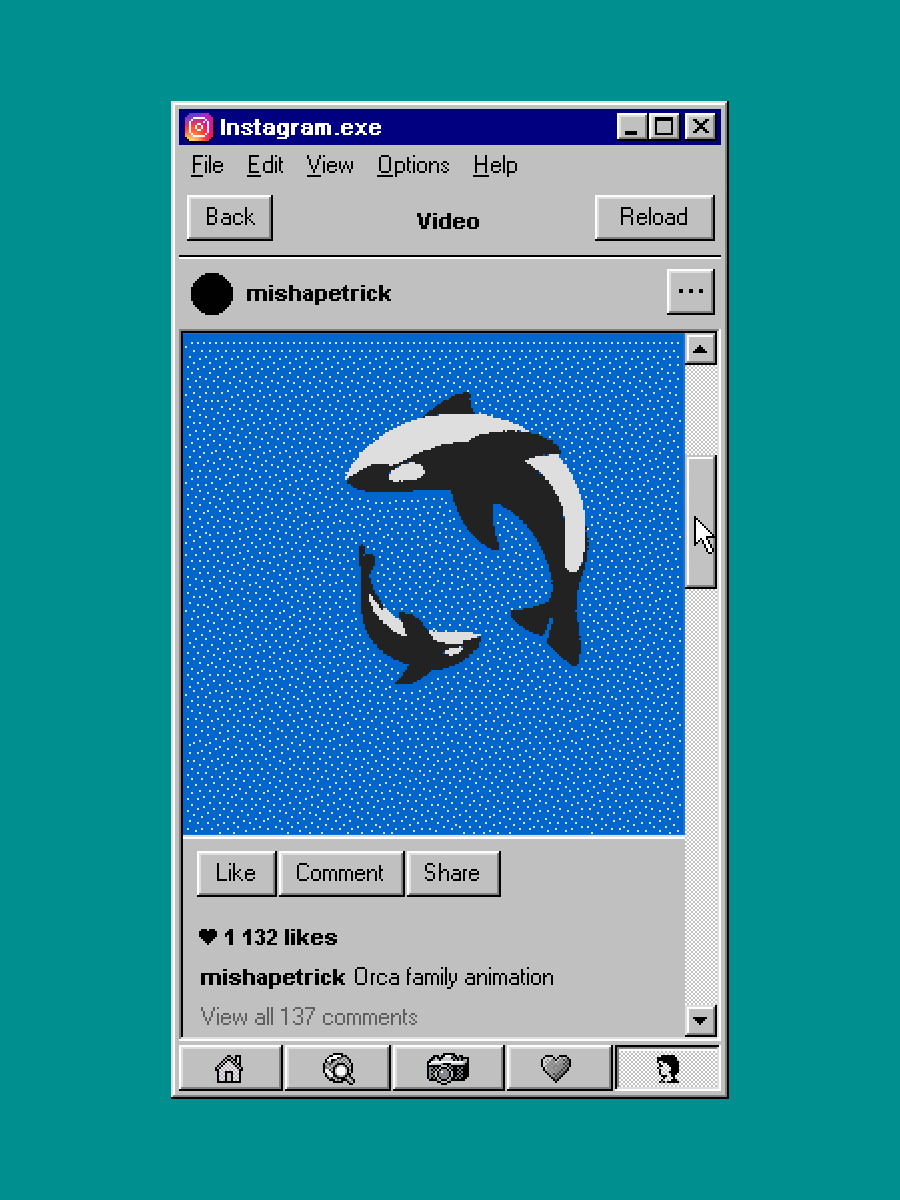
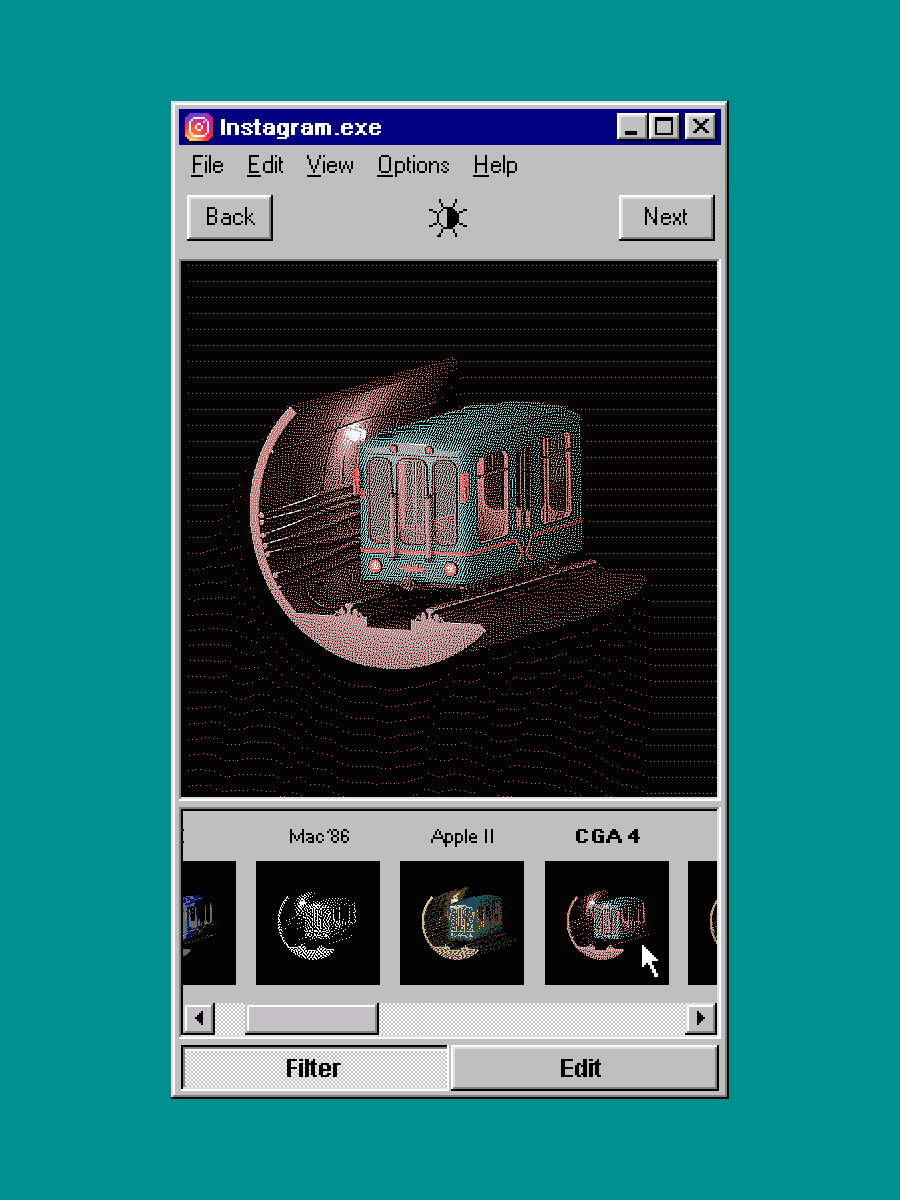

See more of Misha Petrick's work on Behance.
Related:
This Is What Happens When You Repost an InstagramPhoto 90 Times
Edward Snowden's iPhone Hack Wants to Help You Hide Again: Last Week In Art
A lot went down this week in the weird and wild world of Art. Some things were more scandalous than others, some were just plain wacky—but all of them are worth knowing about. Without further ado:
+ Edward Snowden and hacker Andrew “Bunnie” Huang co-designed an iPhone case “add-on” that monitors and disrupts your phone’s radio signals. The case was made, in part, for journalists reporting abroad to protect their information and conceal their whereabouts. [Engadget]
+ Political turmoil in Turkey is impacting its art market. [Artnet News]
+ The new Harry Potter play-cum-book, Harry Potter and the Cursed Child, hit shelves this weekend, and already the internet is full of plot-spoiling trolls. [The Washington Post]
+ Russians in St. Petersburg are voting whether or not to put some pants on a plastic recreation of Michelangelo’s David. [BBC]
+ The website for LA's The Hammer Museum has been infiltrated by M&Ms espousing excerpts of artists’ statements, courtesy of net artist Guthrie Lonergan. The work, Built with Indexhibit, is part of the museum’s current show, Made in L.A. 2016: a, the, though, only, and has elicited some truly incendiary responses from website visitors. [Hammer Museum via ArtFCity]
Screenshot by the author via
+ Having children is a challenge for female artists, said Marina Abramović to the German daily, Tagesspiegel. “I have no husband, no family, I’m totally free.” [Artnet News]
+ Rashid Johnson will be the second-ever artist to be appointed to the Guggenheim Foundation’s board. [Artforum]
+ Donald Trump is being prosecuted by Luciano Pavarotti’s family for his use of the tenor’s famed aria “Nessun Dorma” during his rallies. [The New York Times]
+ At St. Paul’s Cathedral in London this September, Bill Viola will unveil his latest large-scale video installation of Mary supporting Jesus’ body. The video, simply entitled Mary, complements Viola’s other installation in the cathedral’s south side, Martyrs (Earth, Air, Fire, Water). [The Guardian]
+ In Philadelphia, Rock The Vote brought the works of Banksy, Shepard Fairey, and many other artists focused on issues surrounding the 2016 campaign (gun violence, women’s rights, homelessness) to the doorstep of the DNC. [NBC]
+ Shanghai Project, the brainchild of Hans-Ulrich Obrist and Yongwoo Lee, is undergoing some serious re-organizing due, allegedly, to poor planning on the organizers’ parts, and a lack of funding. The biennial’s inaugural exhibition has been delayed until April of next year, to be replaced this September by a community-oriented event with pavilions, library pop-ups, and public forums. [The Art Newspaper]
+ It seems like more people should know about Hannah Höch, the founder of the photomontage, whose work was condemned as “degenerate” under the Nazi regime. [New York Magazine]
+ The Tor Project says that they have proof of sexual misconduct by Jacob Applebaum, a former employee, hacker, and artist. [The Verge]
+ People are shocked that Fisk University sold two pieces that it owned, one a prized Florine Stettheimer, to provide some financial relief to the school. [The New York Times]
+ A French court has denied Orlan’s 31.7 million dollar case against Lady Gaga, which the performance artist leveled for the plagiarization of her imagery in Gaga’s "Born this Way" music video. Orlan now must pay the pop star and her label over $11,000 each. [The Observer]
+ Why Dan Brown is wrong: an informed perspective on the actual significance of Da Vinci’s The Last Supper. [The Smithsonian Magazine]
+ Through their “Artist/City” program, Bortolami Gallery is renting out nontraditional exhibition spaces and giving artists across the country free reign to self-curated shows at any point during the year. In Cahokia, Illinois, for example, artist Eric Wesley will soon become resident of a former Taco Bell. [The Art Newspaper]
+ An initiative for an increase in the acquisitions of African-American art is leading the Detroit Institute of Arts to become more representative of the demographics of its hometown. [Hyperallergic]
+ Pharrell Williams has composed the score for a new dance performance by Jonah Bokaer and Daniel Arsham for the Guggenheim’s Works & Process program this September. [TimeOut New York]
+ Propel announced a line of official Star Wars drones, which you can now reserve. They have 0-30 acceleration in 3 seconds, perform “aerial stunts,” and participate in “laser battles.” [Wired]
+ India’s culture ministry is developing a system to grade the country’s artists in three categories: outstanding, promising, and waiting. [Artforum]
+ London’s top museums have received the renewed sponsorship of BP and people aren’t pleased. [City A.M.]
Did we miss any pressing art world stories? Let us know in the comments below!
Related:
Leonardo DiCaprio's Art Auction Raises $45 Million: Last Week in Art
100 Naked Women, 'White Elevators,' Stephen Colbert at the RNC: Last Week in Art
Naked Blue Bodies and Brooke Shields, Curator | Last Week in Art
Recommended on Medium: "Self-hosting doesn’t help more people self-publish" in Boris Mann’s Blog
The Discussions You Can’t Google
We often wrestle with how advanced discussions in a community should be.
Should we let people come and ask the simplest, easiest, questions in our community?
Or should we demand that discussions should take place at a more advanced level?
Here’s a simple rule of thumb. Discussions in a community should focus on answers you can’t Google.
If we’re looking for a designer, we can search for designers. If we want to get a list of trusted designers that others have worked with and would recommend, that probably requires asking the question.
If I am overwhelmed with information on a topic and want to know which information is most accurate by the experiences of others, I need to ask others.
If we’re looking to find an accountant that has experience working with UK companies with staff employed in the USA and the tax issues involved, that’s probably not an easy question to Google.
If we want to know what everyone else is working on this week, we’re going to need to ask others like us.
If we’re looking for a sense of connection and to get a sense of how people like us setup their ideal workday, we need to ask that question of people like us. Google won’t help much there.
If we want to know how others afflicted by the same disease we have have handled feeling exhausted while expected to appear strong, we probably need to ask that in a community.
Most of the discussions you have with friends are probably questions you wouldn’t be able to Google.
I’d argue if people can Google the answer to a question, it probably doesn’t belong in a community. You can’t compete with Google. But Google shouldn’t be able to compete with you.
Now I broke it. And I own all the parts.
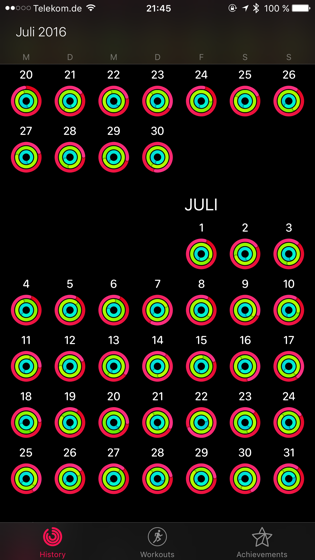
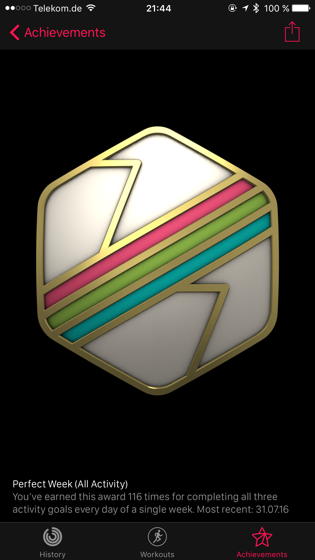
Apple Activity has given up. I keep piling on perfect days, and I seem to have screwed up the backend. I have now been awarded the perfect week 116 times. But I only have had the Apple Watch for 61 weeks and three days. Which is 430 days.
I only missed the move goal on June 20 by three calories, as well as on the very first day. That makes it 428 perfect days, which is way less than 116 weeks. Next goal that Activity cannot track is 500 days mid-October.
Bruce Schneier on sloppy IoT security causing real world disasters
Classic information security is a triad: confidentiality, integrity, and availability. You’ll see it called “CIA,” which admittedly is confusing in the context of national security. But basically, the three things I can do with your data are steal it (confidentiality), modify it (integrity), or prevent you from getting it (availability).
So far, internet threats have largely been about confidentiality. ... On the Internet of Things, integrity and availability threats are much worse than confidentiality threats.
Twitter Favorites: [spain_grain] @ottoscholl I know the rule. You cannot go back to the mound in the same inning if you go to another position
@ottoscholl I know the rule. You cannot go back to the mound in the same inning if you go to another position
Twitter Favorites: [skeskali] Okay, sure, Justin Trudeau was at Pride, but our mayor wore a MUSCLE SHIRT. https://t.co/PiorenHdrI
Okay, sure, Justin Trudeau was at Pride, but our mayor wore a MUSCLE SHIRT. pic.twitter.com/PiorenHdrI
Uber and Didi – There can be only one
Uber exits China. Didi will become the one.
- Hot on the heels of the legalization of ride hailing in China, it looks as if the two big players will now merge to create a single entity that will dominate the local market.
- This is the classic end game scenario for many network based businesses that are fighting tooth and nail for dominance in a market.
- It looks likely that Uber will sell its China operation to Didi Kuaidi in a deal valuing the combined entity at $35bn in which Uber will have a 20% stake.
- This is a clear signal that despite its marketing message, Uber is the weaker player in China and was suffering from being a foreign company competing with a local champion.
- At the same time Didi Kuaidi will invest $1bn in Uber at a valuation of $68bn.
- This deal makes complete sense because the main reason that these companies are haemorraging money is because they are offering discounted rides to millions of customers to try and win them over.
- As they become one company, there will be only one go to place to hail a car via a smartphone for both passengers and drivers.
- Hence, there will no longer be any need for discounts to win share and the result is very likely to be higher fares going forward.
- This is the nirvana of all network based businesses as when one becomes the go to place to buy or sell a product or service, then the company can really start to make profits.
- This is a classic example of how a network based business must have 60% share or be double the size of its next competitor in order to make money (see here).
- If marketing is to believed, both Didi and Uber China are roughly the same size and are currently slashing each other’s throats in order to become the go to ride hailing service in China.
- This is why I have long believed that one of these companies would buy the other and clearly this has been in the works for some time.
- The catalyst is the legalisation of ride hailing as it would have been very difficult to get regulatory approval for a merger of companies whose products are technically illegal.
- RFM research indicates that in territories where Uber is dominant, it is already profitable and once this takeover is complete, the same is likely to be true in China.
- However, it looks very much as if Uber is effectively exiting the China market and ride hailing like every other Digital Life service in China will become a Chinese service for Chinese users delivered by Chinese companies.
- From Uber’s perspective this transaction also makes sense as it is coming under increasing pressure to make money and the prospect of that any time soon in China was looking very unlikely.
- Hence it looks like Uber is backing away from its plan to dominate the globe but will instead settle for a big piece of it but at excellent profitability.
- This is bad news for Baidu which had backed Uber China against its rivals Alibaba and Tencent (who backed Didi) as it will now be a very junior player in Chinese ride hailing.
- That being said, Baidu has the best understanding of the ecosystem which combined with its low valuation keeps it my favourite choice for China and one of my top 3 globally.
Always makes my day

A few years ago I decided to drop ads from this site. It's free as in free beer. It has always been free as in freedom. I don't take money from advertisers, I don't do sponsored posts, nothing. I do get test samples, but I don't own them. However, when readers send me candy or stuff from my Amazon wish list, that is always a very welcome surprise. Thank you, Alper!
And yes, I know, the items on my wish list are awfully expensive. It's very difficult for me to find stuff I don't already have and have put off for purchase later. Please do not send me anything that you can hardly afford. I can easily buy these things for myself. And I will actually do, later.
Shield Break
Nutze des jüngsten Pangu-Entsperrers für Apple-Geräte berichten über Merkwürdigkeiten bei Kreditkarten, Paypal- und Social-Media-Accounts. Das chinesische Jailbreak-Team weist die Vorwürfe zurück.
Ihr müsst das wirklich mal lernen. Das ist kein Jail Break. Das ist ein Shield Break. Wie hieß es letztens in einem Kommentar? "These people have their reasons, most of them are fully aware of the security risk and they decided to accept it." Na, viel Glück damit.
Vanity Project
I have known for years that my “good side” is my left side — it began with an advantage and is gaining on the right all the time. In my teens, a mole appeared in the middle of my right cheek. It’s not small enough, pigmented enough, or close enough to the mouth or eye to qualify as a “beauty mark,” providing Barthesian punctum, the poignant accident; it merely mars the profile. I have a snaggletooth, my upper right lateral tooth, which began twisting out of line as soon as my braces were removed. It’s cute, to a point. It sometimes catches on my lip when I smile. One morning just before my 27th birthday, I fainted and fell into a French door, breaking one of the panes with my face. The glass sliced my chin open, from lower lip to jaw, requiring 15 stitches. The scar is on the right. My right side seems to be aging faster, inexplicably — the nasolabial fold is more pronounced — though the left side gets more sun exposure in the car, and when I sleep on my side, I usually turn to the left.
It was only recently, however, that I realized I automatically look at my good side in the mirror. Because vision is stereoscopic — the two “beams” of your gaze converge at a point, rather than remaining parallel — you can’t look someone in both eyes at once; you have to pick one eye at a time. Standing in a hotel bathroom, its mirror huge and immaculately clean, I suddenly noticed that when making “eye contact” with myself, I look at my left side. Reflexively, I gaze into my left eye.
There’s a high probability that your face also has a good side, and that your good side is the left. Studies have shown that photographs of faces manipulated to be left-symmetrical (so both sides are the left side) are routinely judged to be more attractive than right-symmetrical faces, both in terms of reported “pleasantness ratings” as well as according to unconscious responses such as pupil dilation. One theory supposes that this is because the left side of the face shows more emotion: “Our results suggest that posers’ left cheeks tend to exhibit a greater intensity of emotion, which observers find more aesthetically pleasing,” researchers wrote. “Our findings provide support for…the notions of lateralized emotion and right hemispheric dominance with the right side of the brain controlling the left side of the face during emotional expression.”
The photographer Julian Wolkenstein did a series of “Symmetrical Portraits” in 2010, showing each subject’s right-symmetrical and left-symmetrical photos side by side. The portraits are somewhat unsettling; the resulting faces look related but not identical, like sisters but not twins. Also, perfectly symmetrical faces dip into the uncanny valley, appearing alien or clone-like.
Maybe we prefer our mirror image to photographs, especially candid photographs, because the photograph is objective; the reflection is enhanced
Comparing the half-clones, I find the emotion theory plausible. One blond woman is more conventionally attractive on one side — her eyes more catlike and farther apart, squinting slightly in a Tyra Banks–style “smize”; her nose narrower and pointier at the tip; her cupid’s bow more defined — and more androgynous on the other, her overall countenance less taut. The androgynous side looks somehow less intelligent — but then, we routinely gauge more attractive people to be more intelligent; it’s called the halo effect.
In a popular Quora thread, the top answers to the question “Why do I look good in the mirror but bad in photos?” all revolve around the “mere exposure effect,” which states that we prefer things simply because we are more familiar with them. Photos often capture unfamiliar angles, but even taken head-on, like a mug shot, they show us our true face, not the reversed face we see in the mirror. It’s the reflection that’s inaccurate, but to us, the unreversed face looks wrong.
The best test we have for self-consciousness — which may be the same as consciousness — is something known as the mirror test. It’s administered by putting a subject under anesthesia and then marking their face with an odorless paint. When the subject comes to, they are presented with a mirror. If the subject looks in the mirror and touches their face to investigate or remove the mark, we know they are self-conscious — they recognize the image in the mirror as themselves.
The mirror test has been performed on many different species. Chimpanzees pass the mirror test, but monkeys don’t. Results with gorillas have been mixed. Dolphins and magpies also pass the mirror test. Children pass the mirror test, but not until the age of about 18 months, at which point they also begin to demonstrate “self-emotionality,” or self-conscious emotions, such as pride and shame.
I am fascinated by so-called “mirror delusions,” which can occur with brain damage or degenerative diseases like Alzheimer’s. These patients cease, in a sense, to pass the mirror test; they no longer recognize themselves in their reflections, and believe their reflection is someone else, often an enemy. In Stranger in the Mirror, Robert V. Levine describes a woman named Yolanda, who became convinced that her reflection was a woman named Ruth. “I want her to come over but she doesn’t want to come over,” Yolanda said of Ruth. “I’m tired of talking to her through the window.” She was described by her doctors as seeming “fond” of Ruth. Another woman, Donna, developed a much more antagonistic relationship with her reflection; she felt haunted by the “ugly hag” in the mirror, who would mock and mimic her. A third woman, R.D., felt similarly stalked by an “old bag” who “never told me her name”: “When we get home, you know what? We’re gonna find her waiting right around the windows. In the windows where she watches…I can’t stand her.”
Two of these women refer to the mirror as a window: If we don’t see the reflection as ourselves, we may not notice that the glass is reflective. However, these patients typically persist in recognizing others in mirrors; they have not forgotten what mirrored surfaces do, nor do they have generalized prosopagnosia (the inability to recognize faces). It is only themselves they fail to recognize. Brain scans and autopsy reports reveal that patients like these almost always have right-side frontal lobe damage.
Another set of studies has shown that there is more right-brain activity when we encounter images of ourselves (what scientists call “the self-face”) or hear our own voices. According to psychologist Julian Paul Keenan in The Face in the Mirror, we also recognize our own faces faster when our right brains are active (which is tested by constraining the image to one visual field or asking the subject to respond with their left hand). This leads to the conclusion that the self, the sense of self, is not distributed throughout the brain but located in the right hemisphere.
I wonder, since the right brain controls the left side of the face, if we are drawn to left-symmetrical faces because they display — not more emotion — but more selfhood? Do I look at my left side because I locate my self there?
Think of a memorable experience from your childhood. Do you embody your childhood self in the memory, or do you see it as though from across the room, or a bird’s eye view?
There is something fundamentally different about mental images drawn from memory — when you picture a friend or a celebrity, say — and your self-image. The brain seems to build a self-model, a representation of your own body within your mind, so robust that you may glimpse or even confront your own “avatar” in certain fringe states of consciousness — dreams, memories, and fantasies where you watch yourself in the third person — and through the course of “glitches” in conscious experience, such as out-of-body experiences (known in the literature as “OBEs”) or autoscopy, the spooky phenomenon of seeing your own double.
Certainly what we see in general is not entirely the result of vision. The mind builds a model of our environment based on sensory input, which functions well for our purposes but is not identical with the “real world.” Attention and assumptions play a large role in this, which is what causes “change blindness.” In one well-known study, participants asked to focus on a task didn’t notice when a man in a gorilla suit walked through the room. It’s almost as though people are seeing a cached version of the world that, to save processing power, hasn’t been refreshed.
Only when looking at the photo do I see the asymmetry — so I keep my expression neutral, the neutral face I confront over sinks
But according to cognitive scientist and philosopher Thomas Metzinger, our mind not only builds a world model but also a model of the self to exist in that world model — our inner avatar. In The Ego Tunnel, Metzinger posits that we need this avatar to experience selfhood. All experience is mediated, but we don’t experience the mediation as such, in part because we identify so completely with this avatar. What we experience as direct access to the actual physical world through our actual physical body is really just an extremely immersive user interface. Rather than experiencing the world directly, we move through life in a kind of continual virtual reality.
This feeling of self-identification can be extended outside the body. In the famous rubber hand experiment, subjects were induced to identify with a rubber hand on the table when their own hand was out of view. The illusion is apparently so easy to recreate that you can do it as an impromptu party trick. Race car drivers say that they don’t have to think about the dimensions of their car — when driving they feel like the car is their body. The same goes for people who use a cane every day or have artificial limbs. They completely internalize the new dimensions of their “body.”
This provides evidence for our mental ability to identify with an avatar—it’s as though selfhood can float outside the body and latch onto something else. In a typical OBE, the “astral body,” a doubled self, seems to exit the body through the head and hover near the ceiling, so it can view the now “empty” body below. Of course, you have not actually left your body; instead the self-model seems to be replicating. These “replicants” may contain errors. Metzinger mentions an epileptic who, during a seizure, saw himself from the outside, wearing the same clothes but with “curiously” combed hair, whereas he knew his own to be uncombed.
On the other hand, there are phantom limbs. Amputees frequently continue to feel the presence of their missing limb and even feel pain in it, suggesting that the mental self-model can be so persistent and strongly ingrained that changes to the physical body are difficult to incorporate into a new mental model — that the mind is not as plastic as the body. Or perhaps it’s that the sense of self expands more readily than it retracts, that the mind is resistant to reducing the scope of the self. I am reminded of the poet Anne Boyer remarking on Twitter that she did not identify with recent photos of herself because her hair was missing, following treatment for breast cancer. Of course, I thought: phantom hair.
How accurate, then, are our mental models? There’s a pop-psych idea that people in general (women, especially) are plagued by low-level body dysmorphia, believing ourselves less attractive than we really are. But there’s evidence to the contrary. One study found that people were more apt to “recognize” themselves in photos when their images had been enhanced — that is, Photoshopped to appear more attractive. This points to an innate vanity. Maybe we prefer our mirror image to photographs, especially candid photographs, because the reflection more closely aligns with our self-model. The photograph is objective; the reflection is enhanced. Further, change blindness could explain why we suddenly appear old to ourselves on camera. We have grown old in real life but have been blind to those changes in the mirror; our mental model has not adjusted. When the delusional woman stops seeing her reflection as herself, her idealized self, she sees instead a mean old hag to be avoided.
My favorite variety of mirror delusion is known as “negative autoscopy.” When this rare condition occurs, the patient — like a vampire — cannot see their own reflection in the mirror. To me, this has devastating implications, suggesting that what we see when we look in the mirror is not what is reflected at that moment but what we expect to see: our self-model. If we sustain damage to the area of the brain responsible for the self-model, we may be unable to construct a reflection.
And how much damage can the self withstand? The Cotard delusion, also known as “walking corpse syndrome,” causes patients to stop using the first-person pronoun and deny that they exist. This led one sufferer, known as “Mademoiselle X,” to believe she was incapable of dying; she starved herself to death. Physiologically, it is thought to be related to the Capgras delusion, a form of prosopagnosia where those with familiar faces are experienced as impostors. But here it is the self-face that is seen as an impostor. We no longer see or believe external confirmation that our mental self-model is real — a delusion which can lead to a catastrophic loss of self.
The proliferation of self-facing digital cameras makes it easier than ever to produce self-portraiture, to confront non-mirror-images of ourselves. When I tell my friend C that I’m writing about vanity, she tells me that she has taken a photograph of herself every day since she was 27, when she purchased a laptop with a built-in webcam. “I am obsessed with knowing how my face ages,” she says, “and I want to know what my basic expression is.” I have noticed that people who take and post selfies on the internet tend to choose photos from the same angle and showing the same expression. I think we must choose the photos that look most like our self-image; that self-image is then reinforced and reified by the photos.
If I try, with my phone camera, to reproduce the image that I see in the mirror, I fail. The “live” camera shows me a mirror image, but once I take the photo, the image gets flipped, unreversed, my real face. My mirror image looks symmetrical to me, because I look at my left side and unconsciously assume symmetry. Only when looking at the photo do I see the asymmetry — the deeper crease on one side by the nose, the right eyelid drooping slightly. So I usually turn my face to the right, showing more of my left side. I keep my expression neutral, the neutral face I confront over sinks.
Some months ago, my friend A, then working on his dissertation, recorded me speaking about poetry on his expensive new DSLR camera and cut the footage into a short film. Some of the footage was shot outside a bar in daylight, that soft, late-afternoon light referred to dreamily by director-types as “magic hour.” This footage in particular horrified me. Supposed magical properties notwithstanding, the light seemed to magnify every flaw on my person: the facial scar, the sun damage, the second-day hair limp and stringy in the breeze, the tendency to frown and sneer while concentrating. It was not just that I found the angle or lighting unflattering, not quite to my standards — my reaction was vehement. I felt the person in this film was hideously ugly, much uglier than my idea of myself, but more so, uglier than anyone I know. Though I knew it to be irrational, deathlessly vain, I was shaken to the core. I got drunk and cried.
Later, I read that people react strongly to images of themselves that they don’t consciously recognize, often with powerful dislike. In one study cited by Keenan, men and women were shown images of their own faces and body parts (their hands, for example) without being informed that is what they would see and asked to rate their response. Some recognized themselves in the images and some didn’t, but “non-recognition resulted in highly extreme ratings (for example, highly attractive and highly unattractive)…subconscious recognition appears to have a strong influence.” Perhaps my reaction to the video was a combination of recognition and non-recognition. I knew full well the woman speaking was me but could not square the visual with my mental self-image — the serene, impassive, almost expressionless face I find in a mirror or cultivate on camera.
Being called beautiful has made me vain, in the sense of self-consciousness, much as being photographed makes me temporarily over-aware of my body and my interface
My friend T once called me “beautiful by the conventional metrics,” then added that he didn’t mean it as faint praise — clearly intuiting that women, “intellectual” women at least, prefer to think of themselves as “unconventionally attractive.” Until then, I had. But I am white and blond and thin. Had I flattered myself by thinking my looks interesting, even while identifying with my more conventionally attractive images? “Conventionally beautiful and not conventionally beautiful both sound like insults,” I said.
I like to be called beautiful in the moment, of course, but later I half-resent it. I want, somehow, for others to think me beautiful without having to think of myself as beautiful — the myth of beauty without vanity. Being called beautiful has made me vain, not in the Narcissus sense, but in the sense of self-consciousness, much as being photographed makes me temporarily over-aware of my body, my interface — “this mortal coil,” I sometimes think of it. It is not what Shakespeare meant at all, but when I hear the phrase, I imagine my physical form is a skin I can shed like a snake.
I asked C to send me a few of her photos. She complied, writing:
I’m sending you four pictures of myself — two new, two old. The difference is probably obvious. Here’s what I see in them: I am simply more interested in life now than I was then. My lips used to be fuller and have gotten thinner. I think I used to look less like a specific person, more like a generalized girl, now I look like me more exactly.
“I used to look less like a specific person… Now I look more like me exactly.” I can see what she means. In the more recent shots, her gaze connects; it is piercing and intelligent. In the older photos, she seems to be trying to catch herself off-guard. I think of a woman I know who worked in door-to-door sales one summer; she was coached to be found looking off into the distance, as though distracted, when her mark opened the door. This was supposed to make her seem unassuming, less threatening. The goal was to get inside.
Blogging the way it ought to be
 Function follows form.
Function follows form.
Since the form of a WordPress blog (which this is) favors writing long pieces over short ones, that’s mostly what I’ve written here, since I started in August 2007. Essays, you might say.
Since the form of a 1999.io blog is writing pieces of any length, and posting them easily from a WYSIWYG editor, I’ve been blogging there instead of here. At least lately. My last post here was on June 29. Since then I’ve put up 31 posts at 1999.io:
- Idle words that aren’t
- Bots vs. Humanity
- Leading thoughts
- The Best Way to Blog
- Looking for something
- Promotion as friction
- Open Source lives, to say the least
- A Cajun network pioneer
- Remembering what they probably never taught you in school
- An Unnecessary Fight: Wired & Condé Nast vs. Customers
- The only code I learned was Morse
- Internet for the 100%
- On the continuing death of over-the-air TV
- The risk of being dead wrong
- Shootings
- What have I done?
- Speaking of dubious
- Yum.
- I loved it
- A fire sale on CBS’ legacy
- Knicks & Nets
- Kinda like mass hypnosis
- Stereo—it’s all in your head now
- Approaching the end of radio’s antenna age
- Some helpful additional AirBnB questions
- AM radio musings in Quebec
- What will Verizon do with Flickr?
- Maybe Canada is the control and the U.S. is the experiment
- Listeners to public radio stations: loose the pre-roll on your live stream
- Waiting for Verizon to screw Yahoo users and customers
- Yahoo users and customers have plenty to cry about
Posting on 1999.io is easier than tweeting. It’s even easier than it was on my original blog, where I posted from 1999 to 2007. Take a look at that one. Note that the posts are any length I liked.
Both systems were created by Dave Winer. Hats off to Uncle Dave for bringing back blogging like it used to be, should have been all along, and shall be again.
Should public administration scholarship be subjected to the same transparency standards as political science? A response to Lars Tummers
This is an expanded response to Dr. Lars Tummers’ essay on transparency in Public Administration Review’s Speak Your Mind section. The original is located here. I also blogged about qualitative vs quantitative standards a few weeks back but I had not published that essay, which is live now and can be read here.
Professor Lars Tummers wrote an excellent essay for Public Administration Review’s blog Speak Your Mind that raises fundamental issues with which I am very familiar with, as I’ve taken part of the discussions in the political science realm, from a qualitative researcher perspective. Many of the responses to Lars’ essay have addressed these points at much longer length than I could possibly do, and I can’t make justice to the debate in a few short lines, so I’m just going to raise a few points from a very personal perspective.
1) I am wholeheartedly in favor of more open science, replications, transparency, pre-registration and a number of elements of a more robust, causal-mechanism-driven social science. I work with experimental methods (I was originally trained as a chemical engineer, so I did experiments before experiments were cool in social sciences) and therefore I espouse many of the views of several posters here, including Professor Tummers.
2) I am trained as a political scientist who works in a public administration department. As a result, I have read (and written about) the debates (which were actually happening in political science well before public administration caught up to them). This debate hasn’t ended and is still heated. The LaCour and Green and Alice Goffman issues have only contributed to elevating the level of discussion and the need for an open conversation about this.
3) I do, however, conduct qualitative (primarily interview-based, ethnographic and discourse analysis) research. I don’t want to enter into a discussion about whether the epistemology and ontology of social sciences should be divided in qualitative and quantitative methods. This debate is never going to end, so I strongly recommend reading Tom Pepinsky and Jay Ulfelder on why the discussion on qual/quant divides may actually be detrimental rather than useful.
Put another way, world isn't divided into quantitative & qualitative things. Quantification is just a function of clarity, info, & effort.
— Jay Ulfelder (@dtchimp) January 20, 2015
4) Based on the fact that I conduct ethnographic work in very vulnerable communities, I am rather wary of sharing raw data (e.g. my field notes) with anybody to leave them for interpretation. Identification of vulnerable populations in any kind of social science reporting is not well seen, and many would see it as actually harmful. The IRB principles are there for a reason. We need to protect those communities we study and avoid any kind of harm to them.
5) Let’s not forget the fact that I’m a pre-tenure, tenure-track professor (a factor that plays into me being disincentivized to share raw data – what if someone who writes/analyzes data faster than me comes up with a faster analysis than I can possibly produce? My tenure committee isn’t going to judge me for data production, they’ll judge me for publications in high impact journals).
6) Even when I do quantitative analysis, I very often create my own datasets and therefore I am wary of sharing them before I have exploited them (see point 5). Transparency is rad, and I’m all for letting people judge the quality and rigor of my work by examining my databases and how I processed them (e.g. publishing code, etc.) BUT I am not ok with someone publishing a paper with my database BEFORE I get a chance to do so. Again, we are not rewarding data production, we are rewarding journal article/book publication.
7) What I think is missing from the conversation is a series of tables (sorry, I think in diagrams and tables) creating possible scenarios and then describing EXACTLY what the TOP guidelines would require from a researcher to comply with them. For example – my next paper is on the politics of water privatization in Mexico. Do I need to publish the raw data? Do I need to submit the raw transcripts of my interviews? Should I post them anonymized (anonymity will reduce the ability of researchers who might want to replicate my study to learn more of the contextual elements of my analysis)? I think that’s what is missing. A simple, visual, easy guide with several scenarios, containing MANY examples from the qualitative and interpretive traditions.
In summary, do I think public administration scholarship could use more transparency? For sure. We need to be able to test whether claims in PA journals actually can be sustained by the evidence presented and by the data collected. But PA suffers from the same emerging chasm between quantitative and qualitative research. I don’t want PA to fetichisize quantitative analysis as more rigorous. There is plenty of qualitative, interpretive, ethnographic research that is robust and analytical. I want a more rigorous PA scholarship and stronger, robust, testable research designs. That’s what I want, and that’s what I hope we can all contribute.
(and yes, I just saw the 2016 IPMJ summary article on ethnography in public management research, BTW). I also participated in the session at PMRC where the analysis presented by Ospina, Esteve and their PhD student showed, and I quote Esteve from Twitter “7.5% qual studies in top PA journ. last 5 years. Presenting it at PMRC & S. Ospina ![]() ”
”
@donmoyn @abwhitford @PAReview @LGTummers @raulpacheco 7.5% qual studies in top PA journ. last 5 years. Presenting it at PMRC & S. Ospina

— Marc Esteve (@Esteve_Marc) June 9, 2016
Thanks Andy Whitford, Steve Kelman, Lars Tummers and Don Moynihan also for excellent discussions on Twitter on this topic. I leave you with one of the discussions I enjoyed the most about this topic in the tweets below:
@cjacuff @treycausey @dtchimp 1/ All research is qualitative; some is also quantitative
— Gary King (@kinggary) January 21, 2015
Charlie’s Tree has Fallen on Highway 1

There is not much that can deviate the Trans-Canada highway, but this 300 year old Douglas Fir located beside the east bound lanes between the 176th and 200th Street exits did.
It was not much to look at these days and you probably saw it, a tree stump covered in English Ivy with a white cross, a wreath, and the moniker “Charlie’s Tree”.
Five life long friends as children used to swim and fish near this Port Kells location in the early 20th century. Five of them went to World War One in Europe. Only one, Charlie Perkins, a Royal Flying Corps flight instructor returned. To honour the memory of the four friends who had died in war Charlie Perkins memorialized a grand Douglas Fir with ivy, wreaths and flags.
The memorial was accepted by the community and was never questioned until the Surrey leg of Highway 1 wanted to locate the road through the field-and the tree. Charlie was incensed. As reported by True Surrey
“Charlie was a senior but that didn’t stop him protesting. In fact, he hauled a chair out into the middle of the road, placed a gun across his knees and didn’t budge. It wasn’t long before he was joined by friends, neighbours – true Surrey citizens. Folks who valued this living epitaph enough to make a stand. And amazingly, they won! Highway 1 weaves around Charlie’s tree to this day.”
More information about Charlie Perkins is available here.
The tree had been torched by vandals in the past and had been topped. But the Whalley Legion still places a wreath at the base of this old Douglas fir every year. On the weekend the stump of the tree split, and crashed on the highway. While there was a car crash, no one was hurt. Let’s hope the memory of Charlie’s Tree continues on this British Columbia Day.

Ohrn Image — Public Art
Created at the Maritime Museum for the Vancouver Centennial in 1986, here’s a big story told in one place. It’s about Vancouver’s working water, all too often little known or invisible, while we focus on and debate every other aspect.
From Illustrated Vancouver.ca, with many thanks.
Through a series of interconnected images, this mural tells of the people and ships that played a vital role in shaping the history and culture of Vancouver. Two centuries of activity are traced in time from left to right.” (information sheet from the Maritime Museum)
In the upper left, the “Lions” represent the geographic outlook of Vancouver. The activity on the sea is represented by images of First Nations peoples and their canoes and Captain George Vancouver and his ship Discovery along with Valdes and Galiano and their ships Sutil and Mexicana from 1792.The image also shows Captain GH Richards who surveyed the area and his ship Plumber as well as the Beaver, the first steamship on the coast, a Hudson Bay Company supply vessel, along with others.
In the diamond in the centre of the image is the Empress of Japan and its famous dragon figurehead which is in the Museum’s collection. Modern freighters and luxury steamers complete this section of the picture. The Lions Gate Bridge, built in 1939, is depicted, as is the St Roch, the RCMP patrol vessel that worked the North-West Passage in the early 1940s, which is housed in the Maritime Museum. Also shown are the Ivanhoe and the Master, wood-hulled tugs from the early 20th century.
The harbour is depicted by Canada Place with its cruise ship facility and the Saskatchewan Grain Pool elevator and a Japanese freighter. The people who work in the harbour are also shown, identifiably Joe Fortes, the legendary English Bay lifeguard.
The mural was created for the Vancouver Centennial in 1986. It is a project of the Vancouver Legacies Programme in cooperation with the Vancouver Maritime Museum and a gift to the city from the firm of Rand and Edgar, Barristers and Solicitors.
Granville Street north from Helmcken
Here’s another of the unidentified Archives images. Like others we’ve looked at where there’s no location or date, so we’re slething out an identification. The location is easy – the street sign has been flipped round, but even the building on the corner is the same. It looks as if it was vacant then; today it’s one of the few remaining XXX Adult stores on Granville – or anywhere else. The building dates back to 1909. Originally the single storey retail on the corner was built with 125 foot of frontage (the 75 feet to the north were redeveloped with 3 floors in 1960). Maclure and Fox were the architects for T Godman, and the whole development cost $20,000. We’re pretty certain that the developer was Richard Temple Godman, a London businessman from a military family. He was in partnership with a Vancouver-based broker, and built a couple of other investment properties here; he also seems to have had interests in San Francisco which he visited several times, and the Godman family had built the earliest buildings in Port Renfrew on Vancouver Island, and operated a cannery there.
In terms of dating the image, that’s a Mark 2 Ford Cortina (1967-1970), so we’re at the end of the 1960s or early in the 1970s. There’s no sign of the Scotiatower in the Vancouver Centre, so it’s before 1975, and the sign on the Vancouver block was removed in 1974, so it’s earlier than that. When it was removed it read ‘Birks’ – the ‘Gulf’ version was a year or two earlier, so this is probably somewhere in the first few years of the 1970s.
In the older image today’s Templeton restaurant was the Fountain Café – ‘Chinese food, fish and chips, steaks and chops’. It was Adele’s Cafe in 1934, in 1956 it was sold to Top Chef Cafe and renamed Top Tops and it became the Templeton in 1996. There a mural on the end wall by artist and activist Bruce Eriksen which dates from the late 1960’s. Leslies Grocery was Sunny Grocery – but the 7up sign was the same one. Q Carpets and Interiors had a huge sign, competing with Belmont Furniture across the street in the Glenaird Hotel – now a backbacker’s hostel. Behind it the Capitol condo tower has filled in a big chunk of sky, replacing the Capitol Theatre. Nobody in the early 1970s was listening to music, or checking their phone as they crossed the street.
Image source: City of Vancouver Archives CVA 800-2102
Try Postgres in August, Get a Free T-Shirt

PostgreSQL is a favourite database around Compose. From our in-house developers to our customers, we've come for the relational database and discovered PostgreSQL's rich SQL dialect, with features to aid analytics and warehousing. And then there's PostgreSQL's ability to store, index and query JSON data without losing the schemas and structure of a relational store. Add to that PostGIS's comprehensive geo data support and other extensions just a click away in the Compose console and you have a veritable powerhouse for your data.
If you haven't explored the power of PostgreSQL yet then this month is a great month to try it. Spin up a PostgreSQL instance in August and we'll let you settle down with one of Compose's limited edition shirts - the PostgreSQL one of course. A limited edition shirt for trying out a database of limitless possibilities.
Go ahead and get started
If you’re already up and running with Compose, just login, click deployments and spin up a new Postgres instance.
If you haven’t tried Compose, head over and sign up for your free 30 day trial. The trial gives you a chance to try PostgreSQL as well as our other offerings including MongoDB, Redis, RethinkDB, Elasticsearch, etcd and RabbitMQ.
Then I get a shirt?
Yep. After you sign up a new Postgres deployment, you'll get an email with a link to order your shirt. Fill out the form and enjoy the awesomeness of Compose Postgres while you wait for your shirt in the mail.
Learn More
Not sure about Postgres yet? Check out these curated articles from our technical content team to learn more about Postgres on Compose.
Notebooks for iOS and Mac Organizes Your Research and Reference Materials

There’s a reason why there have been so many different notebook-style apps on iOS and the Mac over the years. Media-rich research projects and reference materials benefit from the familiar metaphor of a notebook as a way to organize everything in one place. The difficulty, though, is balancing organizational functionality with editing tools. Good organizational tools like search, sorting, and sync are a must, but apps that go too deep into editing features can quickly become a bloated mess. Go too light, and the editing features aren’t of much use.
Notebooks by Alfons Schmid is an iOS and Mac notebook app that has excellent organizational tools on iOS and the Mac. With solid search, sorting and sync options, your notebooks and documents are always readily available to you, which makes it a great research tool, especially on iOS. Notebooks' editing tools are a different story. Notebooks for iOS strikes a nice balance with excellent text and PDF editing tools. The more recently released Mac version of Notebooks, however, doesn’t go much beyond text editing, which is a little disappointing.
Whether Notebooks is right for you will depend on the extent to which you want to edit files stored in it and, if so, whether iOS or OS X is the dominant platform you use. People who work on iOS will love the power of Notebooks; on the Mac, Notebooks is closer to a viewer app and may not be sufficient to meet your needs.
iOS

Notebooks’ greatest strength is its flexibility. With the power of several different apps packed into one, it can adapt easily to your particular needs.
Research
Notebooks handles a wide variety of media, which makes it a great research tool for anyone who needs to capture reference material. Whether you are a student, writer, or anyone else that needs to collect information, Notebooks does a solid job of collecting and organizing materials including:
- Webpages;
- Files;
- Photos;
- Videos;
- Music;
- Voice Memos; and
- Drawings.

In most instances, media can either be pulled into Notebooks or pushed to it. From the notebooks view, tap the plus button in the upper right hand corner of the screen, which allows you to create a new notebook, a plain text or formatted note, a sketch, or a voice memo. The same menu lets you import a photo, video, or the contents of a URL. Alternatively, you can use the Notebooks share extension to send a supported file to Notebooks, including text files, photos, videos, iWork files, Office files, emails, PDFs, and others.

The Photos and PDF integrations are the best of Notebooks’ editing tools. Photos can be annotated with a basic drawing tool that includes twelve colors and a slider to choose the width of your drawing stroke. The same tools are available when adding a sketch to Notebooks, just against a white background instead of an image. Unfortunately, there are no cropping, rotation, or filter tools available to edit photos. If you want those sorts of tools, you will have to edit images outside Notebooks and then import them.

Notebooks supports PDF storage and viewing out of the box, but editing tools require a $2.99 In-App Purchase. The additional functionality is well worth it if you find yourself needing to annotate PDFs. The additional tools include text annotation, search, highlighting, stamps, and bookmarking. These are all things that you could get from a dedicated PDF app like PDFpen Pro or PDF Expert, but I’ve found it useful to have them right in Notebooks. You cannot, however, rotate PDFs or make them text-searchable with optical character recognition.

Webpages can be bookmarked or stored in Notebooks, which allows you to view the contents of the page if you have an Interneti connection.
Writing
Whether you are just taking notes or need to write something more polished, Notebooks also includes the basics of a plain-text Markdown editor and formatted text editor. While you are writing in Markdown you will not see the Markdown syntax as you type, unless you go to the settings and turn on Markdown highlighting.

If you prefer to write with formatted text, Notebooks adds an extra row of buttons above the keyboard with over twenty formatting options. The formatted documents you create are HTML under the hood, which allows Notebooks to convert text documents to and from Markdown, though certain formatting will show up in a Markdown document as HTML if there is no Markdown syntax for it. In both cases, when you are finished, you can tap the ‘Process’ button to convert your text to several formats, including plain text, Markdown, PDF, or an eBook.
Task Management
Notebooks also includes a surprisingly full-featured task manager. Documents in a Notebooks can be transformed into tasks by tapping the info button in the toolbar. At first this struck me as odd. Why would a document be a task? But when you think about it, having a way to mark off documents that you have finished reviewing for a project or writing is a good way of tracking your progress. Tasks can also be added to individual documents themselves. When you do so, an indicator will appear in the notebook view that shows how many tasks are contained in that document. For any task, you can also set due dates, alarms, and assign tags.

Navigation
There is obviously a lot going on in Notebooks and it can be filled with all sorts of files, which makes navigation critical. From the notebook view you can search all of your documents by title or content. On the iPad, you can even long tap on a document to open it side-by-side with the current document, which is great for writing on one half of the screen and referencing another document on the other half.
Just as important, though, is the ability to view your files in multiple ways. You can do an ascending or descending sort alphabetically, by date created, by date modified, or a custom manual sort order you create by dragging the notes into a preferred position. You can also create as many notebooks as you need and nest notebooks inside one another.
Mac

Notebooks for Mac shares many of the same features as its iOS counterpart, but is more limited. The Notebooks window is divided into three panes. The first is a home pane that lists your notebooks. Next to that is a list of the documents in the selected notebook. The final pane contains the selected document.
Getting documents into Notebooks is a simple matter of dragging items into the app. I would like, however, to see a Notebooks share extension to make it easy to send things into Notebooks from other Mac apps whether or not Notebooks is open.

Notebooks for Mac does not have PDF or drawing tools. Nor are there image editing tools. If you want to mark up a PDF or alter an image, you can double click the item in Notebooks to open it in the default app for that file type and edit it there. The changes you make in a separate app will be reflected in the item stored in Notebooks.
While I would like to see the feature set of Notebooks for Mac brought in line with the iOS version, it hasn’t been a deal-breaker for me, but that’s because I don’t feel the need for editing tools in this sort of app very often. Typically, I just throw webpages, screenshots and notes into Notebooks and refer back to them later, which works equally well on both platforms with the one caveat being that there is no share sheet support on OS X.
Notebooks isn't without its limitations. The downside of trying to do so much in one app is that it falls short of single-purpose apps. For instance, there is no way to rotate an imported PDF and no fine-grained resizing option for photos. That can be frustrating if you want to work exclusively inside Notebooks. But if you rotate a PDF in something like PDF Expert or resize a photo in a Pixelmator before sending either to Notebooks, you won't miss that functionality in Notebooks.
It really comes down to a matter of perspective. I use Notebooks primarily as a collection tool when I have lots of reference material to collect for a project, not an editing tool, so it suits my needs. Once I've imported documents into Notebooks, there are occasions where I have bumped into editing limits that I'd prefer to handle in Notebooks, but those are more an exception than a rule.
Notebooks for iOS is available on the App Store for $6.99 and Notebooks for Mac is available on the Mac App Store for $19.99.
Like MacStories? Become a Member.
Club MacStories offers exclusive access to extra MacStories content, delivered every week; it’s also a way to support us directly.
Club MacStories will help you discover the best apps for your devices and get the most out of your iPhone, iPad, and Mac. Plus, it’s made in Italy.
Join NowEditing week, Level 1: The power of idea development
Editing is hard. It’s hard to provide useful advice. And it’s hard to take it and use it to make your writing better. This is editing week at Without Bullshit; each day I’ll share my best tips for each of the five levels of editing, as shown in the graphic below. Today: I show how you … Continue reading Editing week, Level 1: The power of idea development →
The post Editing week, Level 1: The power of idea development appeared first on without bullshit.
Recommended on Medium: "Activating great teams everywhere" in Boris Mann’s Blog
Riffing on Bud Caddell’s NOBL ideas



